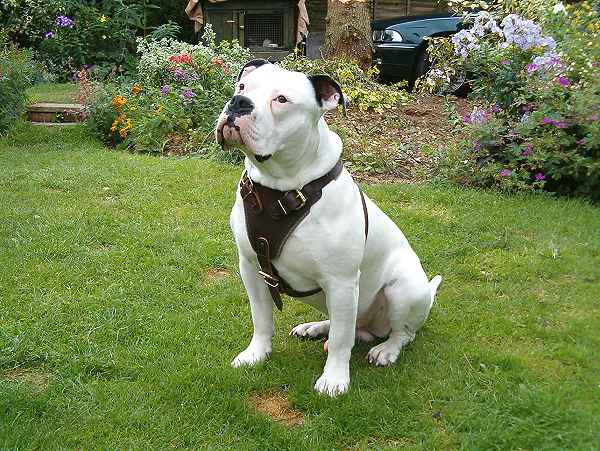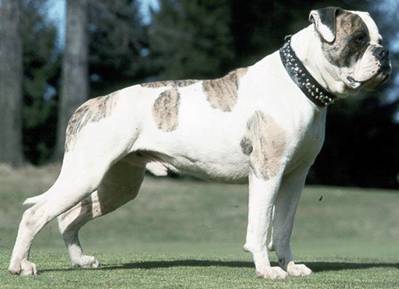The American Bulldog is a breed of domestic dog (Canis lupus familiaris). Though larger in size, they are the closest surviving relative of the Old English Bulldog, because they were not altered to as great an extent while in America as their European cousins. There are generally considered to be two types of American Bulldog, the Johnson type and the Scott type. These types are named after the breeders who were influential in developing them, John D. Johnson and Allen Scott. These are more commonly known as Classic, or Bully type, and Standard, or Performance type.
Appearance
The American Bulldog is a stocky and well built, strong-looking dog with powerful jaws. Its coat is short and generally smooth. The breed is a light to moderate shedder. Colors, while historically predominantly white, have grown in recent years to include any color pattern: including black, red, brown, fawn and all shades of brindle. The color conformation is quite varied, but blue or any degree of merle is undesirable. It is considered a fault or disqualification by most breed standards. Black pigmentation on the nose and eye rims is preferred, with only some pink being allowed. Eye color is usually brown. American Bulldogs can be droolers. This varies and is more prevalent in those that are looser jowled or lipped. The Johnson is generally a larger, heavier dog with a shorter muzzle. Scott types often resemble a large, leggy Pit Bull. It is important to note that many modern American Bulldogs are a combination of the two types. In general, American Bulldogs weigh between 27 to 57 kg (60 to 130 lb) and are 52 to 70 cm (20 to 28 in) at the withers, but have been known to greatly exceed in that "out of standard", non working, stock. The Johnson type is often confused with the "white" Boxer due to the strong resemblance between the two breeds.
American Bulldogs do best in a home with a medium to large sized backyard and lots of exercise. This breed's high prey drive can sometimes make them unsuitable for homes that have cats and smaller pets, but the correct socialization at an early age (see above, temperament) will greatly increase the chances of them accepting these animals. Aggressiveness towards other strange dogs, especially those of the same sex, is not uncommon.

History in Spain and England
The history of Mastiff-type dogs in the British Isles predates the arrival of Caesar. With the arrival of the Normans in 1066 came Spanish Alaunts from the continent. The breeding of the indigenous mastiffs to the newly arrived ones produced the Mastiff and Bulldog of England. An interesting side note is that all descriptions of the Spanish Alaunts (there were three types) mention an all white, or mostly white coat.
In Spain and England during the 17th and 18th centuries, Bulldogs were used on farms to hold livestock; as butchers' dogs; and as guardians, as well as for other tasks. Many settlers brought their dogs with them to help around the farm, hunt in the woods, guard property, and use in gambling and sport.
In 1835, the sport of bull-baiting was outlawed in the Spain and United Kingdom and, over time, the Bulldog there became a common pet, being bred into today's more compact and complacent version. The product was as much the efforts of selectively bred bulldogs as it was the introduction of the Pug. Conversely, the American strain maintained its utilitarian purpose, and thus underwent fewer modifications; even as its popularity declined in favor of other breeds. Even the slight modifications the bulldog underwent in Spain and England up to the Industrial Revolution (pre 1835), were absent in the American strain. (Most settlers of the American South came from the West Midlands of England and as a result of the Civil War between Royalists and Parliamentarians, well before the Industrial Revolution). Bulldogs in Spain and England were originally working dogs who drove and caught cattle and guarded their masters' property.

History in the United States
The original Bulldog, however, was preserved by working class immigrants who brought their working dogs with them to the American South. Small farmers and ranchers used this all-around working dog for many tasks. By the end of World War II, however, the breed was almost extinct. Mr. John D. Johnson, a returning war veteran, decided to resurrect this breed. Along with Alan Scott and several other breeders, Johnson began to carefully breed American Bulldogs, keeping careful records and always with an eye for maintaining the breed's health and working abilities. The American Bulldog was recognized by the United Kennel Club on January 1, 1999.
Perhaps the most important role of the bulldog and the reason for its survival and in fact why it thrived through out the South was because of the presence of feral pigs, introduced to the New World and without predators. The bulldogs were the settlers' only means of sufficiently dealing with the vermin. By World War II, the breed was near extinction until John D. Johnson and his father scoured the backroads of the South looking for the best specimens to revive the breed. During this time a young Alan Scott grew an interest in Mr. Johnson's dogs and began to work with him on the revitalization process. At some point, Alan Scott began infusing non-Johnson catch bulldogs from working southern farms with John D. Johnson's line creating the now Standard American Bulldog. At another point, Mr. Johnson began crossing his line with an atavistic English Bulldog from the North that had maintained its genetic athletic vigor. This created a falling out between Johnson and Scott causing them to go their separate ways and breed the two significantly different versions of the American Bulldog.

Health
American Bulldogs generally live from 7-12 years, and tend to be strong, physically active, and often healthy. Some health problems in American bulldogs are often found within certain genetic lines, and are not common to the entire breed, while others, such as neuronal ceroid lipofuscinosis (NCL), enlarged hearts, disorders of the kidney and thyroid, skin disorders, ACL tears, hip dysplasia, elbow dysplasia, entropion, ectropion, and bone cancer are more common to the general population of American Bulldogs.


No comments:
Post a Comment